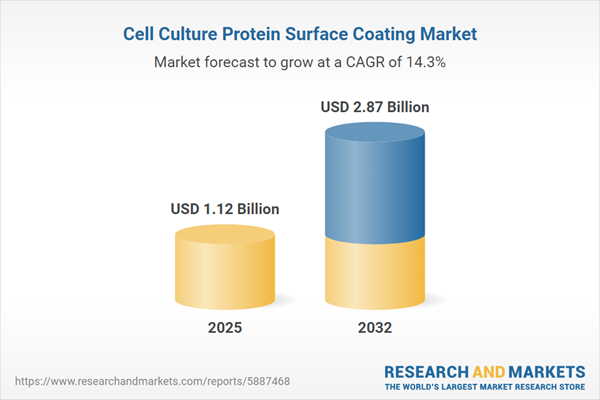Speak directly to the analyst to clarify any post sales queries you may have.
The cell culture protein surface coating market plays a pivotal role in enabling next-generation biological research and accelerating innovation in life sciences. Senior decision-makers can leverage these critical solutions to strengthen experimental reliability and scalability across evolving R&D, bioprocessing, and therapeutic applications.
Market Snapshot: Cell Culture Protein Surface Coating Market
The cell culture protein surface coating market grew from USD 988.96 million in 2024 to USD 1.12 billion in 2025. It continues to expand robustly, supported by a CAGR of 14.25%, with projections reaching USD 2.87 billion by 2032. Strong adoption is driven by rising demand for high-performance coatings across regenerative medicine, drug discovery, and advanced biological research. The ongoing need to replicate physiological environments and streamline high-throughput screening workflows ensures sustained growth and innovation in this sector.
Scope & Segmentation of the Protein Surface Coating Market
This report delivers comprehensive coverage of the protein surface coating market, addressing integral segments, cutting-edge technologies, and key global regions:
- Protein Sources: Animal-derived proteins (collagen, fibronectin, laminin), human-derived proteins (albumin, fibrinogen), plant-derived proteins, and synthetic proteins (poly-L-lysine, polyethyleneimine) for specialized cell culture requirements.
- Coating Methods: Pre-coating and self-coating techniques for varied workflow preferences and research objectives.
- Form: Lyophilized/powdered coatings for long-term stability and ready-to-use liquid coatings for immediate application.
- Technology: 2D cell culture coating for monolayer growth and 3D cell culture coating tailored to advanced tissue constructs and organoid platforms.
- Application: Biopharmaceutical development (therapeutic protein and vaccine production), cell-based assays (drug screening, toxicity testing), stem cell research, and tissue engineering.
- End User: Academic and research institutes, contract research organizations, and pharmaceutical and biotechnology companies.
- Regions: Americas (United States, Canada, Mexico, Brazil, Argentina, Chile, Colombia, Peru), Europe, Middle East & Africa (United Kingdom, Germany, France, Russia, Italy, Spain, Netherlands, Sweden, Poland, Switzerland, United Arab Emirates, Saudi Arabia, Qatar, Turkey, Israel, South Africa, Nigeria, Egypt, Kenya), and Asia-Pacific (China, India, Japan, Australia, South Korea, Indonesia, Thailand, Malaysia, Singapore, Taiwan).
- Key Companies: Industry leaders and innovators, including Corning Incorporated, Thermo Fisher Scientific Inc., STEMCELL Technologies Inc., Merck KGaA, Sartorius AG, and numerous specialist and regional suppliers.
Primary Keyword Focus: Cell Culture Protein Surface Coating Market
Key Takeaways for Senior Decision-Makers
- Protein surface coatings are critical for improving experimental reliability, reproducibility, and biological relevance across cell culture platforms.
- Tailored protein source selection and advanced coating methods are enabling customized solutions for diverse cell types and high-throughput research demands.
- Regional leaders like the Americas continue to drive adoption through robust R&D investments, while Asia-Pacific markets demonstrate rapid growth in scale and application diversity.
- The integration of automation and self-coating technologies is streamlining lab workflows and reducing manual intervention.
- Collaboration among manufacturers, instrument providers, and research organizations strengthens innovation and facilitates faster market entry for new technologies.
- Sustainability considerations and alternative raw material sourcing are shaping operational strategies to address emerging regulatory and cost constraints.
Tariff Impact: Navigating Regulatory and Supply Chain Shifts
Recent United States tariff policies have prompted market participants to reconsider sourcing strategies and distribution networks. Actions such as nearshoring, diversification of raw materials, and fostering domestic supplier partnerships help mitigate cost fluctuations. Increased focus on product certification and supply chain transparency ensures ongoing research continuity despite shifting trade dynamics.
Methodology & Data Sources
The report utilizes an integrated approach, combining primary interviews with laboratory and procurement leaders and in-depth analysis of peer-reviewed publications, industry white papers, and regulatory filings. Scenario modeling and geospatial analysis supplement findings, validating both qualitative feedback and quantitative shipment data to deliver actionable insights for strategic planning.
Why This Report Matters
- Provides a clear, actionable roadmap for optimizing product portfolios, operational strategies, and regional expansions in the protein coating market.
- Equips decision-makers with strategic insights for risk management, technology adoption, and regulatory compliance in a fast-evolving research landscape.
- Supports informed investment in innovation, workflow automation, and collaborative partnerships for sustained market leadership.
Conclusion
The cell culture protein surface coating market is rapidly evolving, presenting opportunities for enhanced precision, scalability, and innovation. By aligning strategies with dynamic market forces and regional drivers, stakeholders can secure a resilient position in life sciences and biopharmaceutical research.
Additional Product Information:
- Purchase of this report includes 1 year online access with quarterly updates.
- This report can be updated on request. Please contact our Customer Experience team using the Ask a Question widget on our website.
Table of Contents
3. Executive Summary
4. Market Overview
7. Cumulative Impact of Artificial Intelligence 2025
Companies Mentioned
The companies profiled in this Cell Culture Protein Surface Coating market report include:- 3H Biomedical AB
- Advanced BioMatrix, Inc. by BICO Group AB
- Biomat Srl
- Corning Incorporated
- Creative Bioarray
- Danhar Corporation
- Eppendorf SE
- faCellitate GmbH
- Greiner Bio-One International GmbH
- Innoprot
- Innovative Surface Technologies, Inc.
- Kollodis BioSciences, Inc.
- Merck KGaA
- Miltenyi Biotec GmbH
- Neuvitro Corporation
- PerkinElmer, Inc.
- Promega Corporation
- Sartorius AG
- ScienCell Research Laboratories, Inc.
- STEMCELL Technologies Inc.
- Thermo Fisher Scientific Inc.
- TissueLabs
- Viogene
- ZenBio, Inc. by BioIVT LLC
Table Information
| Report Attribute | Details |
|---|---|
| No. of Pages | 193 |
| Published | November 2025 |
| Forecast Period | 2025 - 2032 |
| Estimated Market Value ( USD | $ 1.12 Billion |
| Forecasted Market Value ( USD | $ 2.87 Billion |
| Compound Annual Growth Rate | 14.2% |
| Regions Covered | Global |
| No. of Companies Mentioned | 25 |









